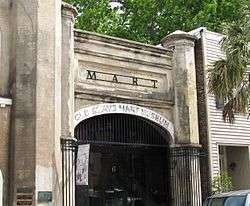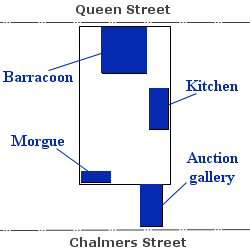Old Slave Mart
The Old Slave Mart is a building located at 6 Chalmers Street in Charleston, South Carolina that once housed an antebellum slave auction gallery.[3] Constructed in 1859, the building is believed to be the last extant slave auction facility in South Carolina. In 1975, the Old Slave Mart was added to the National Register of Historic Places for its role in Charleston's African-American history. Today, the building houses the Old Slave Mart Museum.[1][4]
Old Slave Mart | |
 Old Slave Mart facade | |
| Location | 6 Chalmers Street, Charleston, South Carolina |
|---|---|
| Coordinates | 32°46′38″N 79°55′48″W |
| Area | less than one acre |
| Built | 1859[1] |
| Architectural style | Gothic Revival, Romanesque |
| NRHP reference No. | 75001694[2] |
| Added to NRHP | May 2, 1975 |
The Old Slave Mart was originally part of a slave market known as Ryan's Slave Mart, which covered a large enclosed lot between Chalmers and Queen streets. The market was established in 1856 by Charleston City Councilman Thomas Ryan, after a citywide ban on public slave auctions made private facilities necessary. Slave auctions were held at the site until approximately 1863; in 1865, the Union Army occupied Charleston and closed Ryan's Mart. The Old Slave Mart Museum has operated on and off since 1938.[4]
Design
The Old Slave Mart is a 67-foot (20 m) by 19-foot (5.8 m) brick structure with a stuccoed façade. The front (south side) faces the cobblestone-paved Chalmers Street. The building originally measured 44 feet (13 m) by 20 feet (6.1 m), but an extension in 1922 gave it its current dimensions. The unique façade of the Old Slave Mart consists of 20-foot (6.1 m) octagonal pillars at each end, with a central elliptical arch comprising the entrance.[4]
The building originally contained one large room with a 20-foot (6.1 m) ceiling. In 1878, a second floor was added, and the roof was overhauled. The arched entryway originally held an iron gate; in the late 1870s it was filled in with simple doors. Interior partitions were added in subsequent decades, dividing the first floor into three rooms.[4] Today, there is an iron gate in the archway once again.
History

Throughout the first half of the 19th century, slaves brought into Charleston were sold at public auctions held on the north side of the Exchange and Provost building.[1] After the city prohibited public slave auctions in 1856,[1] enclosed slave markets sprang up along Chalmers, State, and Queen streets. One such market was Ryan's Mart, established by City Councilman and broker Thomas Ryan and his business partner James Marsh. Ryan's Mart originally consisted of a closed lot with three structures — a four-story barracoon or slave jail, a kitchen, and a morgue or "dead house."[4]
In 1859, an auction master named Z. B. Oakes purchased Ryan's Mart, and built what is now the Old Slave Mart building for use as an auction gallery. The building's auction table was 3 feet (0.91 m) high and 10 feet (3.0 m) long and stood just inside the arched doorway.[1] In addition to slaves, the market sold real estate and stock.[4] Slave auctions at Ryan's Mart were advertised in broadsheets throughout the 1850s, some appearing as far away as Galveston, Texas.
When Union forces occupied Charleston beginning in February 1865, the slaves still imprisoned at Ryan's Mart were freed.[5]
In 1878, the Old Slave Mart was converted into a tenement dwelling, with a second floor added.[1] A car dealership and showroom operated in the building in the 1920s, necessitating the expansion of the rear of the building.[4] In 1938, Miriam B. Wilson purchased the building and established the Old Slave Mart Museum, which initially displayed African and African-American art.[1] Wilson operated the museum on a shoestring budget until her death in 1959. Although Wilson was from Ohio, the Old Slave Mart Museum under her ownership embraced local beliefs that slavery had been good for African Americans. Wilson bequeathed the museum and its artifacts (mostly crafts made by African Americans in slavery) to the Charleston Museum which declined to take them.[6]
The City of Charleston and the South Carolina African American Heritage Commission restored the Old Slave Mart in the late 1990s.[7] The museum now interprets the history of the city's slave trade. The area behind the building, which once contained the barracoon and kitchen, is now a parking lot.
References
- National Conference of State Historic Preservation Officers, Old Slave Mart. Retrieved: 27 May 2010.
- "National Register Information System". National Register of Historic Places. National Park Service. July 9, 2010.
- "Old Slave Mart, Charleston County (6 Chalmers St., Charleston)". National Register Properties in South Carolina. South Carolina Department of Archives and History. Retrieved 23 June 2012.
- Nenie Dixon and Elias Bull, National Register of Historic Places Nomination Form for Old Slave Mart, 12 February 1975. Retrieved: 27 May 2010.
- Information obtained from a display in the Old Slave Mart Museum, 2010.
- Kytle, Ethan J.; Roberts, Blain (2018). Denmark Vesey's garden : slavery and memory in the cradle of the Confederacy. The New Press. pp. 244–252, 255. ISBN 978-1-62097-546-6. OCLC 1097077428.
- Jonathan H. Poston, The Buildings of Charleston: A Guide to the City's Architecture (University of South Carolina Press 1997), pp. 64-65.
See also
External links
- Old Slave Mart Museum - official website
- Historic Charleston's Religious and Community Buildings, a National Park Service Discover Our Shared Heritage Travel Itinerary
- Museum Grand Opening Press Release, October 2007
| Wikimedia Commons has media related to Old Slave Mart. |

